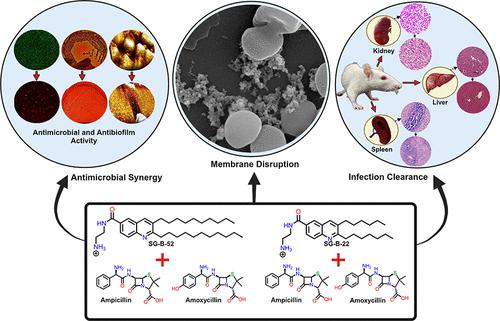当前位置:
X-MOL 学术
›
ACS Infect. Dis.
›
论文详情
Our official English website, www.x-mol.net, welcomes your feedback! (Note: you will need to create a separate account there.)
Synergistic Augmentation of Beta-Lactams: Exploring Quinoline-Derived Amphipathic Small Molecules as Antimicrobial Potentiators against Methicillin-Resistant Staphylococcus aureus
ACS Infectious Diseases ( IF 5.3 ) Pub Date : 2024-03-05 , DOI: 10.1021/acsinfecdis.3c00696 Surojit Ghosh 1 , Samya Sen 2 , Moumita Jash 3 , Satyajit Ghosh 3 , Aniket Jana 1 , Rajsekhar Roy 3 , Nabanita Mukherjee 1 , Dipro Mukherjee 3 , Jayita Sarkar 4 , Surajit Ghosh 1, 2, 3
ACS Infectious Diseases ( IF 5.3 ) Pub Date : 2024-03-05 , DOI: 10.1021/acsinfecdis.3c00696 Surojit Ghosh 1 , Samya Sen 2 , Moumita Jash 3 , Satyajit Ghosh 3 , Aniket Jana 1 , Rajsekhar Roy 3 , Nabanita Mukherjee 1 , Dipro Mukherjee 3 , Jayita Sarkar 4 , Surajit Ghosh 1, 2, 3
Affiliation

|
The escalation of bacterial resistance against existing therapeutic antimicrobials has reached a critical peak, leading to the rapid emergence of multidrug-resistant strains. Stringent pathways in novel drug discovery hinder our progress in this survival race. A promising approach to combat emerging antibiotic resistance involves enhancing conventional ineffective antimicrobials using low-toxicity small molecule adjuvants. Recent research interest lies in weak membrane-perturbing agents with unique cyclic hydrophobic components, addressing a significant gap in antimicrobial drug exploration. Our study demonstrates that quinoline-based amphipathic small molecules, SG-B-52 and SG-B-22, significantly reduce MICs of selected beta-lactam antibiotics (ampicillin and amoxicillin) against lethal methicillin-resistant Staphylococcus aureus (MRSA). Mechanistically, membrane perturbation, depolarization, and ROS generation drive cellular lysis and death. These molecules display minimal in vitro and in vivo toxicity, showcased through hemolysis assays, cell cytotoxicity analysis, and studies on albino Wistar rats. SG-B-52 exhibits impressive biofilm-clearing abilities against MRSA biofilms, proposing a strategy to enhance beta-lactam antibiosis and encouraging the development of potent antimicrobial potentiators.
中文翻译:

β-内酰胺的协同增强:探索喹啉衍生的两亲性小分子作为抗甲氧西林金黄色葡萄球菌的抗菌增效剂
细菌对现有治疗性抗菌药物的耐药性升级已达到关键峰值,导致多重耐药菌株迅速出现。新药发现的严格途径阻碍了我们在这场生存竞赛中的进步。对抗新出现的抗生素耐药性的一种有前途的方法是使用低毒性小分子佐剂增强传统无效的抗菌药物。最近的研究兴趣在于具有独特环状疏水成分的弱膜扰动剂,解决抗菌药物探索中的重大空白。我们的研究表明,基于喹啉的两亲性小分子 SG-B-52 和 SG-B-22 可显着降低选定的 β-内酰胺抗生素(氨苄青霉素和阿莫西林)对致命的耐甲氧西林金黄色葡萄球菌(MRSA) 的 MIC。从机制上讲,膜扰动、去极化和 ROS 生成驱动细胞裂解和死亡。通过溶血测定、细胞毒性分析和白化 Wistar 大鼠的研究,这些分子显示出最小的体外和体内毒性。 SG-B-52 对 MRSA 生物膜表现出令人印象深刻的生物膜清除能力,提出了一种增强 β-内酰胺抗菌作用并鼓励开发有效抗菌增强剂的策略。
更新日期:2024-03-05
中文翻译:

β-内酰胺的协同增强:探索喹啉衍生的两亲性小分子作为抗甲氧西林金黄色葡萄球菌的抗菌增效剂
细菌对现有治疗性抗菌药物的耐药性升级已达到关键峰值,导致多重耐药菌株迅速出现。新药发现的严格途径阻碍了我们在这场生存竞赛中的进步。对抗新出现的抗生素耐药性的一种有前途的方法是使用低毒性小分子佐剂增强传统无效的抗菌药物。最近的研究兴趣在于具有独特环状疏水成分的弱膜扰动剂,解决抗菌药物探索中的重大空白。我们的研究表明,基于喹啉的两亲性小分子 SG-B-52 和 SG-B-22 可显着降低选定的 β-内酰胺抗生素(氨苄青霉素和阿莫西林)对致命的耐甲氧西林金黄色葡萄球菌(MRSA) 的 MIC。从机制上讲,膜扰动、去极化和 ROS 生成驱动细胞裂解和死亡。通过溶血测定、细胞毒性分析和白化 Wistar 大鼠的研究,这些分子显示出最小的体外和体内毒性。 SG-B-52 对 MRSA 生物膜表现出令人印象深刻的生物膜清除能力,提出了一种增强 β-内酰胺抗菌作用并鼓励开发有效抗菌增强剂的策略。



























 京公网安备 11010802027423号
京公网安备 11010802027423号